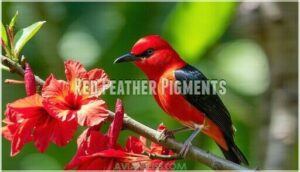This site is supported by our readers. We may earn a commission, at no cost to you, if you purchase through links.

The native ‘Apapane sports a bright crimson head and feeds on ‘ōhi’a nectar, while the curved-billed ‘I’iwi shows off vermillion plumage that’s hard to miss.
The rare Akohekohe, found only on Maui, displays a distinctive red-orange crest.
Among introduced species, you can’t overlook the Red-crested Cardinal with its striking scarlet cap, or the familiar Northern Cardinal that’s made Hawaii home.
These red-headed beauties represent both conservation success stories and ongoing challenges, with some thriving while others face extinction threats that reveal surprising connections between diet, habitat, and survival.
Table Of Contents
- Key Takeaways
- Red Feather Pigments
- Native Red Headed Birds
- Introduced Red Headed Birds
- Ecological Impact Conservation
- Birdwatching in Hawaii
- Frequently Asked Questions (FAQs)
- What birds live in Hawaii?
- Are there red crested cardinals in Hawaii?
- Are yellow billed Cardinals omnivores in Hawaii?
- What do Hawaiian cardinals look like?
- What does a Hawaiian honeycreeper look like?
- When do Cardinals breed in Hawaii?
- What bird in Hawaii has a red head?
- How did red-crested cardinals get to Hawaii?
- What is the tropical bird with a red head?
- What is the native Hawaiian red bird?
- Conclusion
Key Takeaways
- You’ll find Hawaii’s most stunning red-headed birds include native species like the ‘Apapane and ‘I’iwi honeycreepers, which get their brilliant crimson colors from carotenoid pigments in their diet of nectar, fruits, and berries.
- You can spot introduced red-headed species like the Red-crested Cardinal and Northern Cardinal throughout Hawaii’s parks and residential areas, where they’ve established thriving populations after being brought from South America and North America.
- You’ll discover that native red-headed birds face serious conservation challenges, with species like the Akohekohe critically endangered due to habitat loss and disease, while introduced species create competition for resources and nesting sites.
- You’ll have the best birdwatching success during early morning hours in diverse habitats – from sea-level parks for observing Red-crested Cardinals to high-elevation ohia forests above 4,100 feet where native ‘Apapane and ‘I’iwi thrive.
Red Feather Pigments
You’ll discover that the brilliant red feathers on Hawaiian birds come from carotenoid pigments, which they obtain through their diet of fruits, berries, and nectar-rich flowers.
The secret to Hawaii’s most stunning red birds lies hidden in every berry they eat and flower they visit.
Some species can also produce these colorful compounds internally, creating the vibrant crimson plumage that makes birds like the Apapane and I’iwi so striking against Hawaii’s green landscapes.
Carotenoids in Diets
You’ll find that red-headed Hawaiian birds get their stunning colors from carotenoids in their daily meals.
These pigments come from specific dietary sources that birds actively seek out for ideal feather coloration.
- Native berries and fruits – Rich sources that Hawaiian honeycreepers like the i’iwi bird consume regularly
- Flower nectar – Provides essential carotenoids for pigment absorption in Hawaii endemic bird species
- Insect prey – Contains concentrated carotenoids that support vibrant plumage development
Production of Carotenoids
Some Hawaiian honeycreepers like the i’iwi bird don’t just rely on dietary sources for their stunning red feathers.
These Hawaii endemic birds can actually manufacture their own carotenoids through internal carotenoid synthesis. Genetic factors control this pigment metabolism process, allowing birds to convert basic compounds into vibrant red pigments.
This natural feather coloration ability gives Hawaiian birds their distinctive crimson appearance through specialized bird pigmentation pathways.
Ensuring they get enough essential fatty acids can further enhance their feather health.
Native Red Headed Birds
You’ll find Hawaii’s most remarkable red-headed birds among its native honeycreeper species, which have evolved unique adaptations over millions of years.
These endemic species, including the vibrant Apapane and the critically endangered I’iwi, represent some of the world’s most specialized nectar-feeding birds with their distinctive curved beaks and brilliant crimson plumage.
Apapane Characteristics
Looking at these native Hawaiian bird species, you’ll discover the Apapane stands out as Hawaii’s most widespread Hawaiian honeycreeper.
Looking at Hawaii’s vibrant native birds, you’ll find the Apapane soaring as the islands’ most successful honeycreeper survivor.
This vibrant red bird Hawaii calls home measures just 5.5 inches with striking crimson plumage details.
The native Hawaiian bird thrives in ohia lehua forest habitat above 4,100 feet, where its honeycreeper diet includes nectar and insects.
Its nesting habits involve building cup-shaped homes using moss and feathers.
I’iwi Characteristics
You’ll instantly recognize the I’iwi bird by its brilliant scarlet plumage and dramatically curved bill, perfectly designed for reaching deep into native flowers.
This endangered Hawaiian bird serves a pivotal pollination role, especially with ‘ōhi’a trees.
The scarlet honeycreeper’s salmon-colored beak makes it unmistakable among Hawaii’s native species.
As a specialized nectar feeder, this red bird Hawaii treasures faces serious conservation challenges.
Some red-headed birds, like the Red-headed Woodpeckers, also play vital roles in their ecosystems.
Akohekohe Features
Elegance defines the Akohekohe, Hawaii’s most endangered honeycreeper with distinctive orange-red head patches.
This endemic bird faces critical conservation challenges as habitat loss threatens its survival.
- Plumage Details: Striking black body contrasts with bright orange-red head feathers and white neck ruff
- Habitat Specifics: Lives exclusively in Maui’s high-elevation native forests above 4,500 feet
- Diet Uniqueness: Feeds primarily on ohia lehua nectar
Introduced Red Headed Birds
You’ll find several introduced bird species with striking red heads across Hawaii’s islands, each bringing unique colors and behaviors from their original homelands.
These non-native species, including the Red-crested Cardinal from South America and the Northern Cardinal from North America, have established thriving populations and now contribute substantially to Hawaii’s diverse avian community.
Red Crested Cardinal
The redcrested cardinal’s South American origins brought stunning Cardinal Plumage to Hawaiian birds.
You’ll spot this beauty’s bright red head and prominent crest in Crested Cardinal Habitat across residential areas and parks.
Their Cardinal Diet includes seeds, fruits, and insects, while Cardinal Vocalizations produce melodic whistles.
This spectacular addition to Hawaii’s bird watching scene makes bird identification rewarding for Hawaiian bird conservation enthusiasts seeking diverse species.
Northern Cardinal
Northern Cardinals aren’t common sights in Hawaii – they’re actually rare vagrants that occasionally show up.
Unlike the Red-crested Cardinal, these birds sport brilliant red heads, crests, and bodies on males. You’ll recognize them by their robust build and thick orange beaks perfect for cracking seeds.
Their vibrant plumage exhibits sexual dimorphism.
- Cardinal Habitat: Prefers dense shrublands and forest edges when present
- Cardinal Diet: Feeds on seeds, fruits, and insects with powerful beak
- Cardinal Behavior: Males are territorial and aggressive during breeding season
- Cardinal Vocalizations: Known for clear whistled songs and metallic chip calls
Other Introduced Species
Beyond the Northern Cardinal, you’ll spot several other introduced species with red markings across Hawaii’s islands.
The Java Sparrow displays reddish-orange coloring, while Red Avadavat males show vibrant red plumage during breeding season.
Red Junglefowl roam freely in some areas, and the occasional Redhead Duck visits coastal waters.
These bird species from various parakeet origins now call Hawaii home, including species with red markings.
Ecological Impact Conservation
You’ll discover that introduced red-headed birds create significant challenges for Hawaii’s native ecosystems, competing with endemic species for limited food sources and nesting sites.
Conservation efforts targeting these impacts require your understanding of how protecting native habitats and controlling invasive populations helps preserve Hawaii’s unique biodiversity for future generations, which is crucial for maintaining the ecological balance and supporting endemic species.
Negative Impact on Biodiversity
Introduced species in Hawaii create serious problems for native birds.
These newcomers compete for the same food sources and nesting spots that Hawaiian wildlife depends on.
Disease introduction through bird introductions has devastated Hawaii’s native birds, with ecosystem disruption affecting entire forest communities.
Here’s how ecological impact unfolds:
- Habitat competition – Introduced birds claim prime nesting territories
- Native species decline – Original populations shrink as resources become scarce
- Disease introduction – Foreign pathogens spread through bird communities
- Resource depletion – Limited food sources get overwhelmed by larger populations
- Ecosystem disruption – Natural pollination and seed dispersal patterns break down
Conservation Efforts Needed
You can help protect Hawaii’s native birds through supporting habitat restoration projects and predator control programs.
Disease management initiatives like the Birds, Not Mosquitoes program combat avian malaria affecting the Iiwi bird and other rare Hawaiian species.
Public awareness campaigns and funding initiatives, including the $16 million Hawaiian Forest Bird Conservation program, desperately need your support to save these endangered species.
Birdwatching in Hawaii
You’ll find that Hawaii’s diverse elevations create perfect conditions for spotting red-headed birds, from sea-level parks where you can observe Red-crested Cardinals to high-altitude ohia forests that host native I’iwi and Apapane.
Planning your birdwatching expedition around these specific habitats and bringing proper equipment will substantially increase your chances of witnessing these stunning species in their natural environments.
Tips for Birdwatchers
Early morning hours offer the best birdwatching Hawaii experiences when red-headed species are most active.
Bring binoculars, field guides, and practice proper Birding Etiquette by maintaining quiet distances.
Develop Identification Skills by studying Hawaiian birds list beforehand.
Follow Safety Precautions on trails and consider hiring Local Guides for expert knowledge.
Photography Tips include using telephoto lenses to capture these stunning bird species Hawaii without disturbing their natural behaviors.
Enhance your viewing experience with specialized birding equipment.
Best Locations for Birding
Now that you’ve honed your spotting skills, choosing the right island hotspots makes all the difference.
Hawaii’s bird species Hawaii thrive in diverse environments perfect for bird watching Hawaii:
- Forest reserves like Koke’e State Park offer hiking trails where you’ll find endemic Hawaiian birds list species
- Coastal views at Kilauea Point provide seabird identification opportunities
- Urban parks surprisingly host introduced red-headed species year-round.
Consider purchasing birdwatching gear before visiting Kokee Park.
Essential Equipment for Birding
Binoculars remain your most important tool for birdwatching Hawaii’s diverse habitats.
Pack 8×42 models for clear views of Hawaiian bird species in dense forests.
Field guides help identify unfamiliar birds, while spotting scopes reveal distant subjects.
Audio recorders capture unique calls from bird species in Hawaii.
For easy species ID, consider using interactive identification apps.
Your backpack essentials should include water, snacks, and protective gear for comfort during extended birdwatching tips sessions.
Frequently Asked Questions (FAQs)
What birds live in Hawaii?
Hawaii’s avian paradise hosts around 350 bird species like a living kaleidoscope.
You’ll spot 60 endemic natives including the crimson Apapane and I’iwi, plus 170 introduced species like cardinals and finches painting the islands vibrant.
Are there red crested cardinals in Hawaii?
Yes, you’ll spot Red-crested Cardinals throughout Hawaii’s islands.
These striking South American natives were introduced and now thrive in residential areas, parks, and gardens with their distinctive bright red heads and prominent crests.
Are yellow billed Cardinals omnivores in Hawaii?
Those bright crimson-capped beauties you’ll spot darting through Hawaiian gardens aren’t picky eaters.
Yes, Yellow-billed Cardinals are omnivores, happily munching on seeds, fruits, insects, and small invertebrates to fuel their vibrant tropical lifestyle.
What do Hawaiian cardinals look like?
You’ll spot two cardinal species in Hawaii with distinct looks.
Red-crested Cardinals sport bright red heads and crests with white bodies, while Yellow-billed Cardinals have red heads, yellow beaks, and black eye masks.
What does a Hawaiian honeycreeper look like?
You’ll spot these remarkable birds with vibrant crimson-red plumage covering their heads and bodies.
They’re small, measuring about 5 inches, with curved bills perfectly designed for sipping nectar from native Hawaiian flowers.
When do Cardinals breed in Hawaii?
Coincidentally, you’ll find Cardinals breeding year-round in Hawaii’s tropical climate.
Red-crested Cardinals typically nest from March through August, while Northern Cardinals breed mainly during spring and summer months when conditions favor raising young.
What bird in Hawaii has a red head?
Several birds in Hawaii sport red heads, including the native I’iwi and Apapane honeycreepers with their striking scarlet plumage.
You’ll also spot introduced species like Red-crested Cardinals and Northern Cardinals throughout the islands, which can be considered as introduced species.
How did red-crested cardinals get to Hawaii?
Like countless other species, red-crested cardinals didn’t fly to Hawaii on their own.
You’ll find they were introduced from South America, likely brought by people who admired their striking crimson plumage and distinctive crest.
What is the tropical bird with a red head?
The Red-crested Cardinal is Hawaii’s most recognizable tropical bird with a bright red head and prominent crest.
You’ll spot this South American native in parks, gardens, and residential areas across the islands.
What is the native Hawaiian red bird?
Don’t confuse introduced cardinals with Hawaii’s true natives.
You’ll find the Apapane and I’iwi as the islands’ authentic red-headed birds.
These endemic honeycreepers showcase brilliant crimson plumage while thriving in Hawaii’s native ohia forests.
Conclusion
Beautiful birds bearing brilliant red heads make Hawaii’s avian landscape truly spectacular.
Each Hawaiian bird with red head tells a unique conservation story, from thriving native ‘Apapane to endangered Akohekohe populations.
You’ll discover these crimson-crowned creatures represent both ecological success and environmental challenges across the islands.
Whether you’re spotting introduced cardinals or seeking rare native honeycreepers, these red-headed species offer unforgettable birdwatching experiences that highlight Hawaii’s complex relationship between native wildlife and introduced species in a tropical paradise with unique conservation stories.











